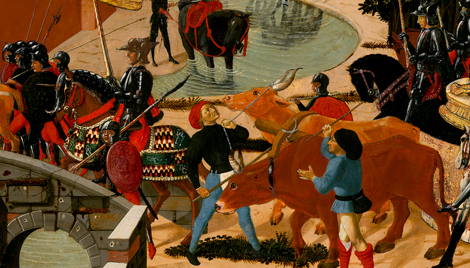Queen Zenobia Addressing Her Soldiers
Queen Zenobia Addressing Her Soldiers
- Artist
- Giovanni Battista Tiepolo
- Artist Dates
- 1696-1770
- Artist Nationality
- Italian
- Title
- Queen Zenobia Addressing Her Soldiers
- Date
- 1725/1730
- Medium
- oil on canvas
- Dimensions
- 261.4 x 365.8 cm (102 15/16 x 144 in)
- K Number
- K1679
- Repository
- National Gallery of Art
- Accession Number
- 1961.9.42
- Notes
Provenance
Possibly Ca' Zenobio, Venice, by 1732[1] until at least 1817 or 1844. [2] Villa Grimani-Vendramin Calergi, Noventa Padovana until 1905 or 1909. [3] (Count Dino Barozzi, Venice). C. Ledyard Blair [d. 1950], Peapack-Gladstone, New Jersey, by 1909. [4] Maisie Dreicer Whyte de Kerchove [1889-1976, née Shainwald, after 1935 Baroness de Kerchove]; sold or consigned 24 February 1948 to (French and Co., New York); sold 7 December 1949 to the Samuel H. Kress Foundation, New York; [5] gift 1961 to NGA. [1] Fern Rusk Shapley, _Paintings from the Samuel H. Kress Collection: Italian Schools XVI-XVIII Century_, London, 1973, connected the painting and its two pendants (now in Milan) with another large painting in Turin, and recognized the works as an early commission for the Zenobio family completed in 1732, and recorded by Vincenzo da Canal in his biography of Tiepolo's teacher Gregorio Lazzarini. George Knox, "Giambattista Tiepolo: Queen Zenobia and Ca'Zenobio: 'una delle prime sue fatture'", _Burlington Magazine_ 121 (1979) related a fifth painting (now in Madrid) to the original commission. [2] The last male Zenobio, Alvise, died in 1817, leaving the palace to his sister Alba, who died in 1837. Renovations to the palace began in 1844, at which time a number of art works were apparently sold: Gianjacopo Fontana, _Venezia Monumentale: I Palazzi_, Venice, 1845-1863: 299 (reprint, editec by Lino Moretti, Venice, 1967). [3] According to an unsigned statement, probably by Count Barozzi (NGA curatorial files). William Suida, _The Samuel H. Kress Collection_, Exh. cat. Philadelphia Museum of Art, 1950-1953, _Philadelphia Museum Bulletin_ 46/227, Philadelphia, 1950, gave the date 1905; Giulio Lorenzetti, "The note Tiepolesche", _Rivista di Venezia_ 14 (1935): 388, gave the date as 1909. On the Villa Grimani-Vendramin Calergi see Mercedes Precerutti Garberi, _Affreschi settecenteschi delle ville venete_, Milan, 1968: 61-63. The villa passed from the Grimani to the Vendramin Calergi in 1740. Upon her death in 1894, the last member of this family, the widowed Countess Valmarana, left the villa and its contents to the Istituto delle Sordomute, which she founded, run by the Suore Canossiane. The archive of the villa was destroyed shortly after 1900, according to Bruno Brunelli and Adolfo Callegari, _Ville del Brenta e degli Euganei_, Milan, 1931: 135-137. Giulio Lorenzetti, "Tre note Tiepolesche", _Rivista di Venezia_ 14 (1935): 388-389, concluded that the painting had been brought from another site. [4] Fern Rusk Shapley, _Paintings from the Samuel H. Kress Collection: Italian Schools XVI-XVIII Century_, London, 1973: 144, and Fern Rusk Shapley, _Catalogue of Italian Paintings_, 2 vols., Washington, D.C., 1979: 1:451, placed Blair's purchase in 1909. The painting was cited in this collection by Giulio Lorenzetti, _Das Jahrhundert Tiepolos_, Vienna, 1942: LIII, and Antonio Morassi, "Settecento inedito", _Arte Veneta_ 6 (1952): 20. The painting does not appear in Blair's posthumous sale, Parke-Bernet Galleries, Inc., New York, 10 June 1950. [5] French and Co. Stock no. 79690AA. Information provided by Martha Hepworth of the Getty Provenance Index, letter dated 9 June 1988 in NGA curatorial files.






